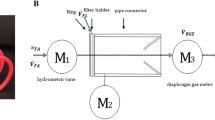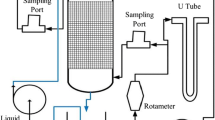Abstract
The collection efficiency and sample retention of a batch-type wetted wall bioaerosol sampling cyclone (BWWC) were experimentally characterized. The BWWC is designed to sample air at 400 l/min and concentrate the particles into 12 ml of water. Aerosol is transported into a cylindrically-shaped axial flow cyclone through a tangential slot and the particles are impacted on the inner wall, which is wetted by air shear acting on a liquid pool at the base of the cyclone. The retention of collected particles and the aerosol collection efficiency of the BWWC were evaluated with polystyrene latex beads (PSL), sodium fluorescein/oleic acid droplets, and Bacillus atrophaeus (aka BG) spores. The retention of particles was determined by adding hydrosol directly into the device, running the BWWC for a pre-set period of time, and then determining the amount of particulate matter recovered relative to the initial amount. For 1-μm diameter PSL, 90% of the particles were recoverable from the cyclone body immediately after their introduction; however, only 10% were retained in the collection liquid after 8 h of operation. The aerosol sampling efficiency was determined by comparing the amount of particulate matter collected in the liquid with that collected by a reference filter. The collection efficiency was 50–60% for 1- and 3-μm polystyrene (PSL) particles, and 1.5% for 10-μm oleic acid particles. The efficiency for 3-μm oleic acid droplets was 35%. Explanations are provided for the difference between liquid and solid particle behavior, and for the low efficiency for the large liquid particles. The collection efficiency for single spore BG was slightly lower than that for 1-μm PSL.







Similar content being viewed by others
References
Barnes, C., Schreiber, K., Pacheco, F., Landuyt, J., Hu, F., & Portnoy, J. (2000). Comparison of outdoor allergenic particles and allergen levels. Annals of Allergy, Asthma & Immunology, 84, 47–54.
Cage, B. R., Gorman, P. G., Going, J. E., Thornburg, M. J., & Soderberg, D. R. (1999). Continuous emission monitoring system. US patent 5,861,316. January 19, 1999.
Cage, B. R., Schreiber, K., Barnes, C., & Portnoy, J. (1996). Evaluation of four bioaerosol samplers in the outdoor environment. Annals of Allergy, Asthma & Immunology, 77, 401–406.
Ferre, F. (1992). Quantitative or semi-quantitative PCR: Reality versus myth. PCR Methods and Applications, 2, 1–9.
Going, J., Cage, B., Thornburg, M., & Soderberg, D. R. (1994). Prototype near real-time monitor for Lewisite in stack gas. Proceedings of the 1994 international incineration conference: Thermal treatment of radioactive, hazardous chemical, mixed munitions, and pharmaceutical wastes. Houston, Texas, May 9–13, 1994. Available from Office of Environment, Health and Safety, University of California at Irvine.
Henningson, E. W., & Ahlberg, M. S. (1994). Evaluation of microbiological aerosol samplers: A review. Journal of Aerosol Science, 25(8), 1459–1492. doi:10.1016/0021-8502(94)90219-4.
Hu, S., & McFarland, A. R. (2007). Numerical performance simulation of a wetted wall bioaerosol sampling cyclone. Aerosol Science and Technology, 44, 160–168. doi:10.1080/02786820601124065.
Kesavan, J., Doherty, R. W., Wise, D. G., & McFarland, A. R. (2001). Factors that affect fluorescein analysis. U.S. Army Edgewood Chemical Biological Center, Aberdeen Proving Ground, Edgewood, MD. Report ECBC-TR-208. AD-A, 397, 677.
Kesavan, J., & Schepers, D. (2006). Characteristics and sampling efficiencies of BWWC and preproduction omni model aerosol samplers. U.S. Army Edgewood Chemical Biological Center, Aberdeen Proving Ground, Edgewood, MD. Report (ECBC-TN-027), October 2006.
Lin, X., & Li, C.-S. (1998). The effect of sampling time and flow rates on the bioefficiency of three fungal spore sampling methods. Aerosol Science and Technology, 28, 511–522. doi:10.1080/02786829808965542.
Lin, X., Reponen, T., Willeke, K., Wang, Z., Grinshpun, S., & Trunov, M. (2000). Survival of airborne microorganisms during swirling aerosol collection. Aerosol Science and Technology, 32, 184–196. doi:10.1080/027868200303722.
Lin, X., Willeke, K., Ulevicious, V., & Grinshpun, S. (1997). Effect of sampling time on the collection efficiency of all-glass impingers. American Industrial Hygiene Association Journal, 58, 480–488. doi:10.1080/15428119791012577.
Macher, J. M., & Burge, H. A. (2001). Sampling biological aerosols. In: Cohen, B.S. (ed). Air sampling instruments for evaluation of atmospheric contaminants (Chapter 23, 9th ed.). American Conference of Government Industrial Hygienists, Cincinnati, OH.
Mainelis, G., Masquelier, D. A., Willeke, K., Makarewicz, A., Dzenitis, J., & Milanovich, F. P. (2006). Performance of a compact air-to-liquid aerosol collector with high concentration rate. Journal of Aerosol Science, 37, 645–657. doi:10.1016/j.jaerosci.2005.06.004.
Masquelier, D. A., Milanovich, F. P., & Willeke, K. (2003). High air volume to low liquid volume aerosol collector. U.S. Patent 6,520,034 B1.
Nevalainen, A., Willeke, K., Liebhaber, F., Pastuszka, J., Burge, H., & Henningson, E. (1993). Bioaerosol sampling: aerosol measurement principles, techniques, and applications (pp. 471–492). New York: Van Nostrand Reinhold.
Olan-Figueroa, E., McFarland, A. R., & Ortiz, C. A. (1982). Flattening coefficients for DOP and oleic acid droplets deposited on treated glass slides. American Industrial Hygiene Association Journal, 43, 395–399. doi:10.1202/0002-8894(1982)043<0395:FCFDAO>2.3.CO;2.
Selvapandiyan, A., Stabler, K., Ansari, N. A., Kerby, S., Riemenschneider, J., Salotra, P., et al. (2005). A novel semiquantitative fluorescence-based multiplex polymerase chain reaction assay for rapid simultaneous detection of bacterial and parasitic pathogens from blood. Journal of Molecular Diagnostics, 7(2), 268–275.
Sigaev, G. I., Tolchinsky, A. D., Sigaev, V. I., Soloviev, K. G., Varfolomeev, A. N., & Chen, B. T. (2006). Development of a cyclone-based aerosol sampler with recirculating liquid film: theory and experiment. Aerosol Science and Technology, 40, 293–308. doi:10.1080/02786820600596891.
Ulrich, M. P., Christensen, D. R., Coyne, S. R., Craw, P. D., Henchal, E. A., Sakai, S. H., et al. (2006). Evaluation of the Cepheid GeneXpert system for detecting Bacillus anthracis. Journal of Applied Microbiology, 100, 1011–1016. doi:10.1111/j.1365-2672.2006.02810.x.
Willeke, K., Lin, X., & Grinshpun, S. (1998). Improved aerosol collection by combined impaction and centrifugal motion. Aerosol Science and Technology, 28, 439–456. doi:10.1080/02786829808965536.
Author information
Authors and Affiliations
Corresponding author
Rights and permissions
About this article
Cite this article
King, M.D., Thien, B.F., Tiirikainen, S. et al. Collection characteristics of a batch-type wetted wall bioaerosol sampling cyclone. Aerobiologia 25, 239–247 (2009). https://doi.org/10.1007/s10453-009-9129-3
Received:
Accepted:
Published:
Issue Date:
DOI: https://doi.org/10.1007/s10453-009-9129-3




